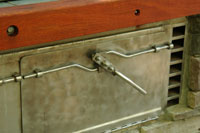My Smoker Design: Concept
"Never tell people how to do things. Tell them what to do and they will surprise you with their ingenuity."—General George S. Patton
One would do well to follow General Patton's advice. I didn't follow this adage on purpose, but I discovered its truth when I asked my fabricator (J&J Truck Bodies) to loosely follow my design concept and measurements. By allowing them to use their expertise to make the serious decisions regarding some of the fit, finish, and functionality of my smoker's construction, I ended up with a better finished product. That's not to say that you would want to give free reign completely to your fabricator, or not give them any guidance, just trust them to make suggestions in your best interest.
In the spring of 2004, I set out to design and build my own smoker after many years of renting one each year for our family's Father's Day party. Year after year I had made a one and a half hour round trip to rent the smoker each time from a rental center in Hagerstown, Maryland, only to make the return trip the following day. And each time I did this, I thought I should build my own since I had already established the Father's Day Pig Roast as an annual event. So I made up my mind to get started with drawing up my plans.

I designed the following drawings, and they were sent to my fabrication welder (who also happens to be a client of mine) with some general instructions to "follow the measurements precisely, and everything else can be at your discression as far as hinges, door handles, etc." My fabricator builds truck bodies by trade, and I trusted their design desisions on anything I didn't specify when it came to structural functionality and integrity.
I designed the hood of my smoker based on a 12-sided polygon, with the bottom 5 sides removed (see figure 2 below). This allowed maximum strength, and would be a little different than anything else I had seen in my research.

figure 1
I had no idea that when completed, this fabricated lid would weigh in at 190 pounds. I still have to figure out an easy way to lift it.

figure 2
As you can see from figure 2 above, I had given no specifications for the length of handle on the hood, the height of the smoke stacks and position, or the size of the hinges. I wanted two smokestacks with louvered openings on the top, but wasn't sure how they should work, and I didn't know a thing about sizing the hinges. I left these decisions to the experts who knew their materials and fabrication process better than me. I trusted they would do a better job specing out the details based on their knowledge and experience in building dump truck bodies.
GRILL GRATE DESIGN
figure 3
This solid stainless grill grate weighs in at 150 plus pounds. I can barely lift this thing out by my myself when it comes time for cleanup. But, I wanted it to outlast me, and therefore asked for something "really beefy".
DRIP PAN
figure 4
The drip pan on my smoker angled toward the center in my drawing, but J&J recommended we build it with a slope left to right angling down toward the drain hole at the right. This added much better functionality. Additionally, it was the only item that I did not make out of 304 stainless — besides the cost factor, I felt that it would hold up to any moisture once it became seasoned, and when stored, (being inside the smoker) it would not be exposed to the elements.
FRONT ELEVATION VIEW
figure 5
I had no idea the guys at J&J would do such a great job on my Fire Doors based on this simple drawing. I did not tell them how thick to make them or what kind of handles to use. They blew me away with their inch and a half thick doors (with air space between two 304 enclosed stainless panels), and trick truck door handles. It just proves my point of "leaving it to the experts".
FIRE DOORS  Two of these doors open separately to feed the coal bed.
Two of these doors open separately to feed the coal bed.



